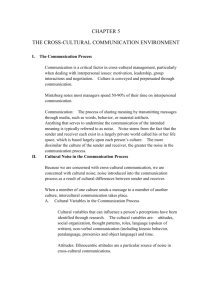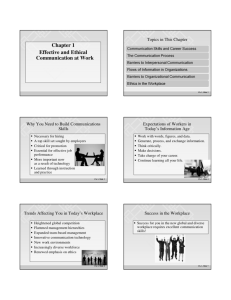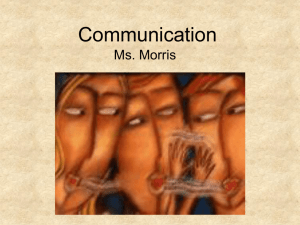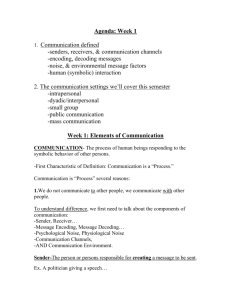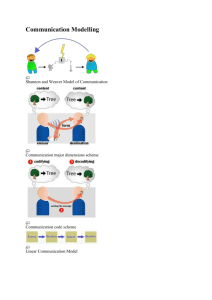What is Communication?
advertisement
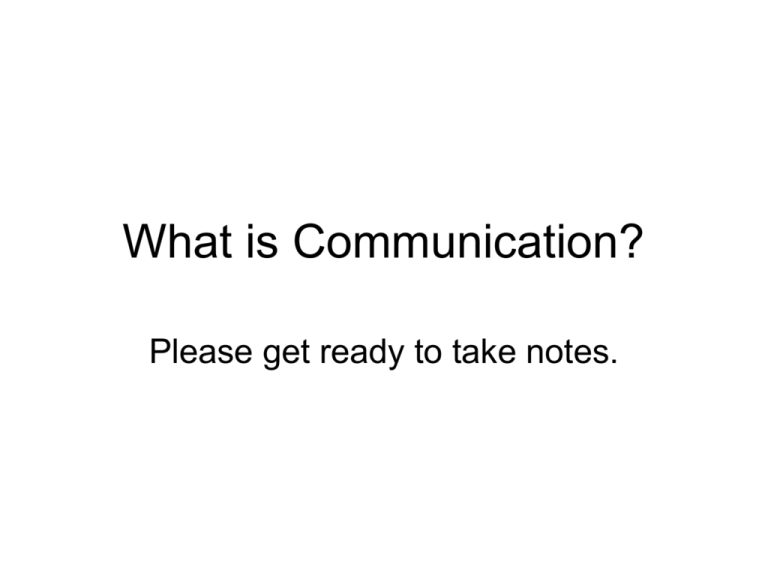
What is Communication? Please get ready to take notes. Quotes about communication: • “Communication is the vehicle which allows humans to recall the past, think in the present, and plan for the future.” Roy Berko • “Good communication is as stimulating as black coffee, and just as hard to sleep after.” Anne Morrow Lindbergh • “The most basic and powerful way to connect to another person is to listen. Just listen. Perhaps the most important thing we ever give each other is our attention. A loving silence often has far more power to heal and to connect than the most wellintentioned words.” Rachel Naomi Remen Quotes cont’d. • “The colossal misunderstanding of our time is the assumption that insight will work with people who are unmotivated to change. Communication does not depend on syntax, or eloquence, or rhetoric, or articulation but on the emotional context in which the message is being heard. People can only hear you when they are moving toward you, and they are not likely to when your words are pursuing them. Even the choices words lose their power when they are used to overpower. Attitudes are the real figures of speech.” Edwin H. Friedman • “The more elaborate our means of communication, the less we communicate.” Joseph Priestley • “Don't knock the weather; nine-tenths of the people couldn't start a conversation if it didn't change once in a while.” Kin Hubbard Communication is: • The deliberate or accidental transfer of meaning; • That which occurs when someone observes or experiences behavior and attributes meaning to it; • A process; • Our link to the rest of humanity. 3 Models for Communication – Communication as Action – Communication as Transaction – Communication as Interaction Communication as Action • Meaning sent or transferred from sender to receiver; Linear input/output • 5 parts: sender, message, channel, receiver, and noise Noise Noise Sender Noise Message Channel Message Receiver What are these parts? • Sender: originator of an idea • Message: written, spoken (verbal), & unspoken (nonverbal) elements of communication to which we assign meaning • Channel: how the message is sent; verbal or nonverbal • Receiver: person or persons to whom the message is addressed • Noise:anything that prevents effective communication at any time. EX: poor sound system, small VA’s, lose signal on cell Noise Noise Sender Noise Message Channel Message Receiver Encode & Decode • Encode: a process of translating ideas, feelings, and thoughts into symbols • Decode: a process of translating incoming information into understandable concepts What’s wrong with this model? • We don’t simply send a message and stop communicating. Often we get a message back; this is called feedback. Noise Noise Sender Noise Message Channel Message Receiver Communication as Transaction • Shannon-Weaver model (1948) • Back and forth, like a Ping-Pong game; we talk, we listen, we talk, we listen • Adds feedback and context Noise Context Noise Sender Noise Message Channel Feedback Message Receiver What are these added parts? • Feedback: verbal or nonverbal responses to a message • Context:physical, social (relationships), psychological, and time element in which communication takes place. PSPT Noise Context Noise Sender Noise Message Channel Feedback Message Receiver Communication as Interaction • Simultaneous; even as we talk we are reacting • Most accurate to our communication process • intercultural Context Noise Sender/ Receiver Noise Message / Feedback Noise Sender/ Receiver Frank Dance’s model • Spiral, helix • Evolves or progresses in a person from birth to the present moment. • Current behavior is affected by past experiences and future behavior is effected by current impacts. T IFF Q are n(U nc omuic kT i m and a r eede pr es e™ Quic kTesimsee™d) decomprrees.so d t o s ed) and a s ee dec o ompr see this pi ctu nc U ( F F I thi s mpr T e needed to pi c tu es s o ar r e. r Quic kT i me™ and a T IFF (Unc ompres s ed) dec ompres s or are needed t o s ee thi s pi c ture. Review • Com. as Action: linear, from sender to receiver • Com. as Transaction: receiver responds to the sender through feedback • Com. as Interaction: simultaneously interactive • • • Assignment You may work by yourself or with up to two other people. Be sure to incorporate all the parts of the models. Choose one of the following: 1. Create a scene of communication and label the parts. (First you will need to draw the scene where the communication situation is taking place, then label the parts.) 2. Draw a cartoon that uses communication and label the parts. 3. Create a math equation for all three communication processes. 4. Act out a scene of communication and label the parts during the scene.

